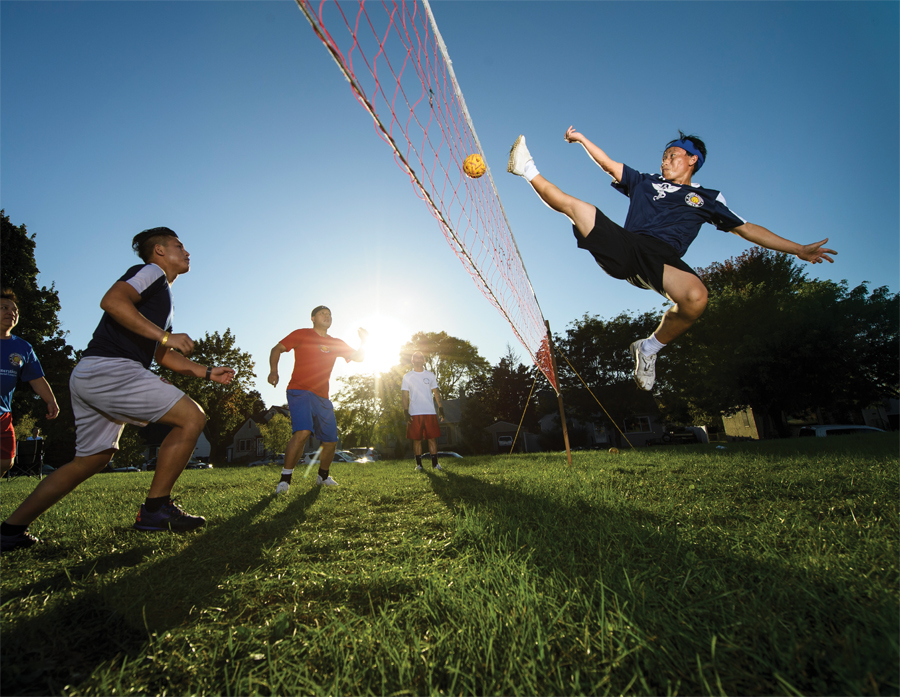
A game in St. Paul’s Frogtown reaches an exciting point
photo by Ryan Taylor
When Lee Pao Xiong’s family fled their native Laos because of the civil war, one thing they took with them was a sport: Sepak Takraw [prounounced: sep-ack ta-krawe]. “It was very popular in the refugee camps,” Xiong says. “There were nets set up everywhere to play.” Xiong arrived in America in 1976, and the sport immediately brought a piece of home to the McDonough Homes project in St. Paul, where his family lived.
“There were no soccer fields, so we just set up the net in a grassy area and started playing.” Before long, there were teams and competitions, including an annual 4th of July tournament, which now attracts players from across the country. Sepak Takraw most likely has roots in China, and its history in Malaysia spans at least 500 years.
It combines the foot skills of soccer with the net play of volleyball. Players can use their feet, knees, head, shoulders, and elbows to get the woven or synthetic balls—about 17 inches in circumference—over the net, resulting in some spectacular spiking. “People love watching because of the acrobatics and the competitiveness,” Xiong says. “A lot of the time, people watch and say, ‘Oh, I can’t do that!’ But there are players who also can’t fly like that but are on the team. There are different roles for everyone.”
Today, Xiong is chair of Sepak Takraw USA, which aims to grow the sport here and get it into the Olympics. Soon, much of that development will take place in St. Paul, where the first permanent Sepak Takraw courts in the U.S. will be built this year in Marydale Park by Loeb Lake thanks to a $100,000 grant from the Super Bowl Host Committee Legacy Fund. When those are built, Xiong expects to see the sport—not just the players—take off.
Get Started
Learn:
Scheffer Recreation Center, lessons in summer. Lessons will also be held at the new courts at Marydale Park and the Duluth & Case Recreation Center in St. Paul.
Language:
Sepak is Malay for “Kick.” Takraw is Thai for “Ball.”
Equipment:
Net (5 feet high), Sepak Takraw ball (plastic now, rattan in the past).
Technique:
Use your feet to get the ball up in the air.
Rules:
Three touches to get the ball over, or lose a point and forfeit the ball. First side to 21 points wins. Similar to volleyball.
Tips:
“Just relax and enjoy the game,” says Xiong. “Be flexible. When you stiffen up, you lose your flexibility. Don’t focus too much on flying. If you see someone who’s flying, they’ve been playing for a long time. Don’t try to impress anybody, and you will be fine.”
Groups:
Events:
“J4” Hmong Freedom Celebration and Sports Festival (Como Park in St. Paul, June 30 and July 1)
Places:
Marydale Park, Duluth & Case Recreation Center, Wellstone Recreation Center, McDonough Recreation Center, Rice Recreation Center
Spirit:
Competitive, team-oriented, fast-paced, focused
High Risk:
Overreach: “I’ve seen some people jump too high, and it’s like the rug got pulled from underneath them,” Xiong says.
Danger:
“Sometimes, if you bend your foot the wrong way, the ball can come and hit you in the head.”
Physically:
Flexibility, speed, and vertical jumps are major assets.
Discover:
The sport is popular across Thailand, Laos, Myanmar, Malaysia, Singapore, and Indonesia.
Benefits:
Sharpen your reflexes, and expand your cultural intake.
Difficulty:
Serving: *
Returning a serve: **
Spiking with a kickflip: ********
Digital Extra: For the Win
Watch last year’s Sepak Takraw championship game in St. Paul, and read about how you can take up this soccer-meets-volleyball sport.








